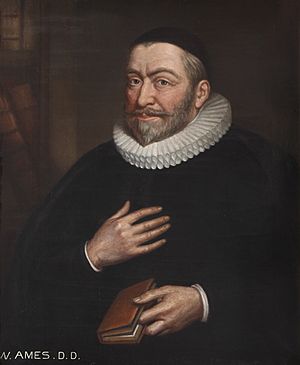William Ames facts for kids
William Ames (pronounced "aymz"; 1576 – November 14, 1633) was an important English minister and thinker. He was part of a group called the Puritans, who wanted to make the Church of England simpler. William Ames spent a lot of his life in the Netherlands. He is well-known for his part in big debates between two groups of Christians, the Calvinists and the Arminians.
Contents
Early Life and School Days
William Ames was born in a town called Ipswich. His uncle, Robert Snelling, helped raise him in Boxford. He went to a local school and then to Christ's College, Cambridge in 1594. Two of his teachers there, William Perkins and Paul Bayne, greatly influenced him. William Ames earned his first degree in 1598 and a master's degree in 1601. He was then chosen for a special teaching position, called a fellow, at Christ's College.
He was quite popular at the university. One of his sermons became famous during the Puritan debates. On December 21, 1609, he gave a sermon at the university church. In it, he strongly criticized students for playing games with dice and for their wild behavior during the Twelve Days of Christmas.
However, a new leader was chosen for Christ's College, Valentine Carey. He disagreed with William Ames because Ames did not like wearing the surplice (a white robe worn by clergy) and other church symbols. William Ames spoke out so strongly that he was called before the university's leader. He was then stopped from working as a minister and from getting any more degrees.
Working as a Minister in Holland
After leaving Cambridge, William Ames was offered a job in Colchester. But the Bishop of London, George Abbot, stopped him from taking it. He faced similar problems in other places. So, he traveled to the Netherlands with another minister, Robert Parker. English business people helped him, hoping he would debate those who supported the English church's ways in Leiden.
In Rotterdam, he debated with a minister named Grevinchovius, who was part of the Arminian group. This debate made William Ames well-known in the Netherlands.
Later, William Ames wrote books to continue his debate with Grevinchovius. They argued about ideas like whether God chooses everyone to be saved or if people have a choice. He put all his arguments into his main book, Coronis ad Collationem Hagiensem. In Leiden, William Ames became good friends with Hugh Goodyear, who was a pastor at the English church there.
Sir Horatio Vere, the English governor of Brill, asked William Ames to come to The Hague. He made Ames a minister for the army there. William Ames married the daughter of John Burges, who was Vere's chaplain. When his father-in-law went back to England, William Ames took his place.
Around this time, he began debating with Simon Episcopius. Episcopius criticized Ames, saying he had caused trouble in England and was now causing new problems in the Netherlands. Hugh Goodyear defended William Ames against these attacks.
William Ames had prepared his book, Coronis, for the Synod of Dort. This was a very important meeting of church leaders that took place from November 1618 to May 1619. Even though the English church leaders had removed him from his army minister job, people still respected him. He was allowed to attend the synod and was paid to observe the meetings. He also advised Johannes Bogerman, who was the president of the synod.
Becoming a Professor
There was a plan to make William Ames the head of a religious college in Leiden. But Archbishop Abbot stopped this from happening. Later, the state of Friesland invited him to be a professor at Franeker. Again, there was opposition, but this time it failed.
He started his new job at Franeker on May 7, 1622. He became a famous professor, preacher, and writer there. One of his students was Johannes Cocceius. Another student was Nathaniel Eaton, who later helped start Harvard College in America.
For his students, he wrote Medulla Theologiae (which means "The Marrow of Theology"). This book was a guide to the ideas of Calvinism. William Ames used a special way of thinking called Ramism in his teaching. He disagreed with the older ways of teaching based on the ideas of Aristotle. His book De Conscientia, ejus Jure et Casibus (1632) was new for its time. It tried to connect Christian rules of right and wrong to real-life situations and choices.
Moving to Rotterdam
After working for twelve years in Franeker, his health got worse. He thought about moving to New England in America. But then he was invited to Rotterdam. There, he wrote his book Fresh Suit against Ceremonies. This book later convinced Richard Baxter to become a Nonconformist (someone who did not follow the rules of the Church of England). The book explained the differences between the Puritan way of thinking and that of Richard Hooker. It was published after William Ames died.
He caught a cold when his house flooded and passed away in November 1633. He was 57 years old and seemed to be in need of money. He had two sons and a daughter with his second wife, Joan Fletcher. His children moved to Massachusetts in America in 1637. His sons later returned to England. His daughter, Ruth, married Edmund Angier in Cambridge, Massachusetts. Their son, Samuel Angier, later married Hannah Oakes in 1680.
His Impact
William Ames's writings were known all over Europe. Most of his works were collected in Amsterdam in five books. Only a small part of them was translated into English. His ideas were especially important and had a big influence in New England, America.


